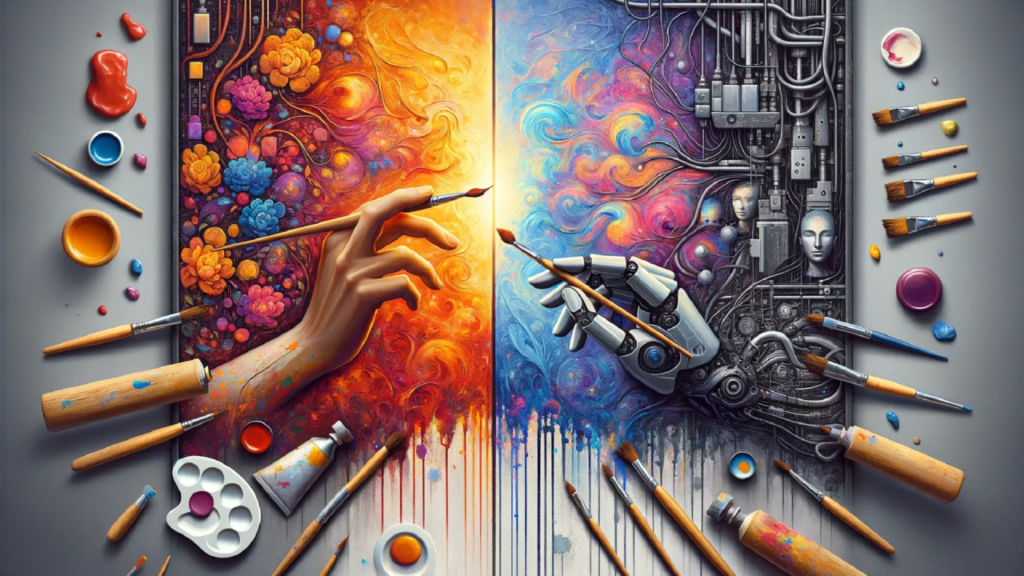Artificial intelligence has made significant strides in various fields, including art and creativity. From generating original paintings to composing music and writing poetry, AI is pushing the boundaries of creative expression. This blog explores the ways in which AI is being used to generate unique content, its impact on the creative industries, and the ethical considerations surrounding AI-generated art.
AI’s ability to create art stems from its capacity to learn and mimic human patterns through machine learning algorithms. One of the most notable AI techniques used in art creation is Generative Adversarial Networks (GANs). GANs consist of two neural networks: the generator and the discriminator. The generator creates images, music, or text, while the discriminator evaluates the quality of the output, providing feedback to the generator. This iterative process results in increasingly refined and sophisticated creations that can sometimes rival human-produced art.
AI-generated visual art has garnered significant attention in recent years. Programs like DeepArt and Google’s DeepDream use neural networks to analyze and reinterpret existing artworks or photographs, creating new and unique pieces. These AI tools can emulate the styles of famous artists or generate entirely novel styles, pushing the boundaries of visual creativity. AI-generated art has even entered the commercial art world, with pieces being auctioned for substantial sums. For example, the AI-generated artwork “Edmond de Belamy” by the collective Obvious sold for $432,500 at Christie’s auction house in 2018.
In the realm of music, AI is composing original pieces and assisting musicians in the creative process. AI systems like OpenAI’s MuseNet and Amper Music can generate music in various genres and styles, offering composers new tools to experiment and innovate. These systems analyze vast amounts of musical data to understand patterns and structures, enabling them to create harmonically and rhythmically coherent compositions. Some artists use AI as a collaborator, blending human creativity with machine-generated ideas to produce unique and captivating music.
AI is also making its mark in literature and poetry. Natural language processing (NLP) algorithms can analyze and generate text, producing poetry, short stories, and even full-length novels. GPT-3, an advanced language model developed by OpenAI, has demonstrated impressive capabilities in generating human-like text. Authors and poets are exploring AI as a tool for inspiration, using it to generate new ideas, experiment with different styles, and overcome writer’s block. AI-generated literature is still in its infancy, but it holds the potential to transform how we approach storytelling and creative writing.
The integration of AI into the creative process offers numerous benefits. It can democratize art by providing tools and resources to individuals who may not have formal training or technical skills. AI can also enhance creativity by offering new perspectives and ideas that humans might not conceive independently. Furthermore, AI can help artists and creators manage repetitive tasks, allowing them to focus on more complex and meaningful aspects of their work.
However, the rise of AI-generated art also raises important ethical considerations. One of the primary concerns is the question of authorship and ownership. When an AI creates an artwork, who owns the copyright? Is it the programmer who designed the AI, the user who provided the input, or the AI itself? These questions challenge traditional notions of creativity and intellectual property, requiring new legal frameworks and regulations.
Another ethical issue is the potential for AI to undermine human creativity. Critics argue that relying too heavily on AI for artistic creation could diminish the value of human effort and originality. There is a fear that AI-generated art might flood the market, devaluing human-made works and reducing opportunities for human artists. Additionally, the use of AI in art raises concerns about authenticity and emotional depth, as machine-generated creations may lack the nuanced understanding and emotional resonance that human artists bring to their work.
Despite these challenges, the collaboration between AI and human creativity holds immense promise. AI can be a powerful tool that augments human capabilities, offering new ways to explore and express artistic ideas. By embracing AI as a partner in the creative process, artists and creators can push the boundaries of what is possible, leading to innovative and groundbreaking works of art.
AI is revolutionizing the world of art and creativity by generating unique content across various mediums. From visual art and music to literature and poetry, AI is expanding the possibilities of creative expression. While ethical considerations regarding authorship, ownership, and the impact on human creativity must be addressed, the potential benefits of AI in art are significant. As technology continues to evolve, the synergy between AI and human creativity will shape the future of artistic innovation, offering exciting opportunities for artists and creators around the world.
By Our Media Team
Our Editorial team comprises of over 15 highly motivated bunch of individuals, who work tirelessly to get the most sought after curated content for our subscribers.




